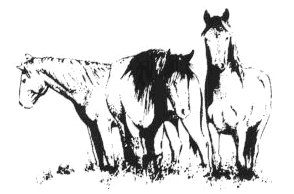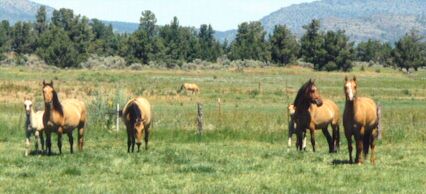|
(Information and graphics courtesy of BLM, Burns District Office)

The Kiger Mustangs are thought to be one of the most pure herds of
Spanish Mustangs existing in the wild today.
When thinking about Kiger Mustangs, you should distinguish them from
most other wild horses. Most wild horses are of mixed breeding while the
Kiger Mustangs possess all of the characteristics of the Spanish Barb from
which the Spanish Mustang came and by today's standards the Kiger Mustang
appears to be a pure breed.
Kiger Colors

The Kiger Mustang exhibits physical color characteristics known as the
"dun factor," which was also common to a major portion of the horses which
the Spaniards reintroduced into North America in the 1600s. Color
classifications of the dun factor are: dun, red dun, grulla (mouse gray),
buckskin and variations of these colors. Markings on horses having the dun
factor include dorsal stripes, zebra stripes on knees and hocks, chest, rib
and arm bands, outlined ears, top 1/3 of the ear on its back side darker
than body color, fawn color inside of ears, multi-colored mane and tail,
cobwebbing on face and face masks. The less white the horses have, the
stronger the dun factor. An individual having the dun factor may have
many, but not all of these markings.
Kiger Mustangs have the physical conformation of both the tarpan and
oriental hotblood horses from which the Spanish Mustangs were bred, and
they are slightly smaller than many of the present day breeds of horses.
They have small round bones and small feet with very little feather on
their legs and fetlocks. Their eyes are wide set and prominent. These
animals also have distinctively hooked ear tips and fine muzzles. The
Kiger Mustangs look very much like the modern day Spanish Sorraias. They
are indeed a unique breed of wild horse.
In 1971 Congress gave the Bureau of Land Management (BLM) responsibility
for "protection, management and control" of wild horses and burros under
the Wild and Free Roaming Horses and Burros Act. The BLM manages two
special areas in Oregon for wild horses having Spanish Mustang
characteristics. The areas were set aside to reduce the chance of losing
all the animals should a natural catastrophe occur. They are located in
the Burns District and are known as the Kiger and the Riddle Mountain
Habitat Management Areas (HMAs).
The Kiger HMA covers nearly 37,000 acres with a herd population
established at a minimum of 51 and a maximum of 82 horses. The Riddle
Mountain HMA contains nearly 28,000 acres and the horse population is
managed to range between 33 and 56 head. When the herds reach the maximum
population (based largely on what the area can healthfully support), excess
horses are rounded up and taken to the Burns Wild Horse Corrals where they
are processed and made available for adoption by the public. The herds
increase at an approximate rate of 20% per year, necessitating a roundup
about every four years.
Periodically horses from one herd are transported to the other to
prevent inbreeding. Quality animals are returned to the herds after
roundups to maintain herd integrity and improve adoptability. There is
high demand for Kiger Mustangs to be used for pleasure and as breeding
stock. They are noted for their intelligence and stamina.
(A Kiger HMA map will appear as soon as we can get it scanned in.)
Seeing the beauty of the Kiger Mustangs in the wild with their classic
coloration and markings will add much to your enjoyment of our western
heritage and is an experience which you won't soon forget. Please remember
to be respectful of the horses as you view them. Stay on marked roadways,
avoid water holes and remember to take binoculars. Remember, it is illegal
to chase, harass or harm protected wild horses or to let your pets chase
and harass them! This is particularly important at foaling season.
Important Note: Vehicular access from the county
road to the view point is limited to 4-wheel drive vehicles in wet
weather.
This is not a BLM operated or BLM sponsored site.
It is run by private wild horse and burro enthusiasts. We are thankful to the
BLM for providing the information which is presented here.

| 

